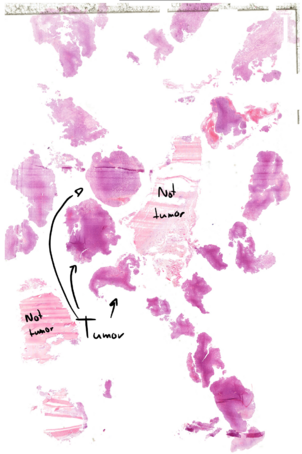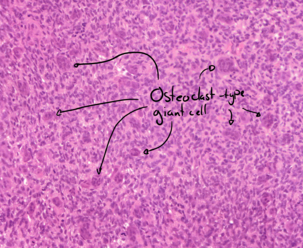49. Giant cell tumor of bone (osteoclastoma): Difference between revisions
(Created page with "'''Staining''': HE '''Organ''': Bone tumor sampled by curettage '''Description''': The purplish things are pieces of the tumor. The pinkish things are not. The tumor pieces are comprised of two types of cell. There are osteoclast-type giant cells, which have large eosinophilic cytoplasm and many nuclei. These cells are not neoplastic; they are reactive cells. The cells that are between the giant cells are the neoplastic cells. These cells are primitive mesenchymal c...") |
No edit summary |
||
| (One intermediate revision by the same user not shown) | |||
| Line 1: | Line 1: | ||
'''Staining''': HE | [[File:Giant cell tumour of bone - overview.png|thumb|Overview|454x454px]]'''Staining''': HE | ||
'''Organ''': Bone tumor sampled by curettage | '''Organ''': Bone tumor sampled by curettage | ||
| Line 20: | Line 20: | ||
The old name for this tumor is “osteoclastoma”. | The old name for this tumor is “osteoclastoma”. | ||
[[File:Giant cell tumour of bone - giant cell.png|thumb|Osteoclast-type giant cell|left|303x303px]] | |||
[[File:Giant cell tumour of bone - giant cell.png | [[File:Giant cell tumour of bone - giant cell2.png|thumb|High magnification giant cell|307x307px]] | ||
[[File:Giant cell tumour of bone - giant cell2.png | |||
[[Category:Pathology 2 - Histopathology slides]] | [[Category:Pathology 2 - Histopathology slides]] | ||
Latest revision as of 14:56, 7 July 2024

Staining: HE
Organ: Bone tumor sampled by curettage
Description:
The purplish things are pieces of the tumor. The pinkish things are not.
The tumor pieces are comprised of two types of cell. There are osteoclast-type giant cells, which have large eosinophilic cytoplasm and many nuclei. These cells are not neoplastic; they are reactive cells.
The cells that are between the giant cells are the neoplastic cells. These cells are primitive mesenchymal cells with poorly defined cytoplasm.
Diagnosis: Giant cell tumor of bone
Risk factors:
- Age 20 – 45
Theory:
The old name for this tumor is “osteoclastoma”.


